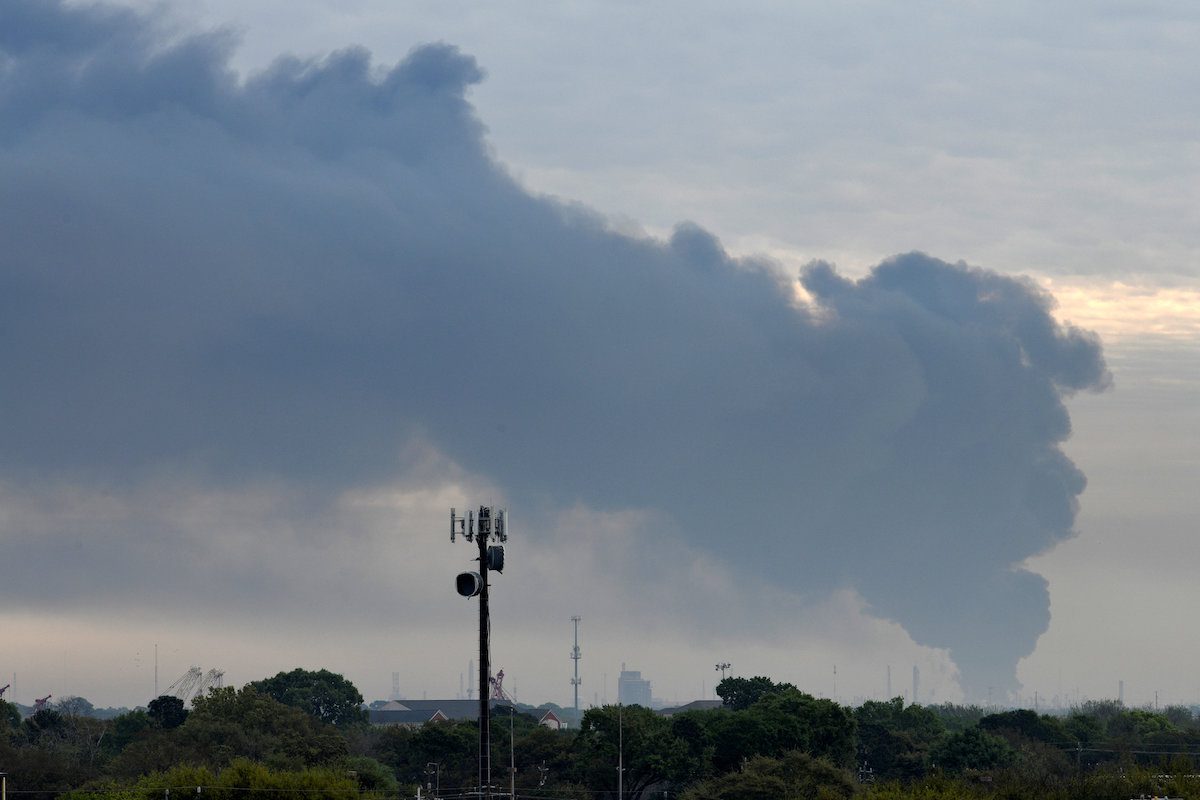Smoke rises from a fire burning at the Intercontinental Terminals Company in Deer Park, east of Houston, Texas, U.S., March 18, 2019. REUTERS/Loren Elliott
By Joe Carroll, Ben Foldy and Kevin Crowley (Bloomberg) — The U.S. Gulf Coast’s most important industrial waterway partially reopened on Monday after it was polluted with cancer-causing benzene and toxic runoff from the region’s worst chemical disaster in more than a decade.
A two-mile (3.2-kilometer) stretch of the Houston Ship Channel’s that’s been closed for three days will be open during daytime hours while the clean-up continues. Pilots have been ordered by the U.S. Coast Guard to stay at least 30 minutes apart so each vessel can be inspected to ensure it’s not dragging oily residue through the water.
The partial reopening means that oil refiners, chemical makers, grain exporters and other industries in Houston’s eastern suburbs are no longer cut off from the Gulf of Mexico and international markets. The Port of Houston handles more than $130 billion in trade annually. Industrial chemicals are by far the largest bulk commodity traversing the waterway, followed by petroleum coke and grain.
More than 30 ships were stranded earlier Monday on either side of the no-go zone as the unfolding Intercontinental Terminals Co. calamity entered its second week, according to Coast Guard figures. Royal Dutch Shell Plc slowed fuel production at its Houston-area refinery because of the disruption to waterborne crude deliveries, Reuters reported.
Petrochemical Fire Halts Ship Traffic on Houston Ship Channel
ITC achieved a significant milestone Sunday in emptying more than half a million gallons of toxic liquid from an onshore tank wrecked in the four-day blaze that erupted March 17 and sent a mile-high plume of black smoke skyward. As of Monday morning, five tanks had been emptied and two more were targeted for draining.
The channel isn’t a source of drinking water for Houston or its suburbs. Dozens of major companies rely on the waterway to receive crude oil and other raw materials, and to send out finished products such as fuel and livestock feed.
ITC crews finally drained about 13,000 barrels (546,000 gallons) of a benzene-laced refining byproduct called pygas from a charred tank on Sunday after two earlier unsuccessful attempts, said Brent Weber, the company’s incident commander.
Tank 80-7
By Monday, that tank — numbered 80-7 on the facility map — had been completely drained, a significant achievement for ITC because it allows crews access to other damaged tanks still holding dangerous chemicals. A 2-foot (0.6-meter) deep pool of chemicals on the ground around the damaged tanks was reduced to 2 inches by Sunday morning.
Benzene levels in the air over suburban Deer Park and neighboring communities remained below harmful levels, said Adam Adams of the U.S. Environmental Protection Agency.
Trust ‘Not There’
That was a far cry from late last week, when readings of the pollutant linked to leukemia and other forms of cancer shut entire towns, triggered panic and sent 1,000 people to a pop-up medical clinic.
Residents remain on edge, wondering what’s next and when normal life will return. For many Houstonians, it’s the worst industrial disaster since the 2005 explosion at BP Plc’s Texas City refinery that killed 15.
“There’s more tanks in there. Is it going to reignite? It’s very uncertain,” said Mercy Reyna, 50, who’s been suffering from headaches, eye discomfort and chest tightness. “The trust is not there. We feel like we’re not being told the truth of what’s going on.”
Texas Attorney General Ken Paxton filed a lawsuit accusing ITC of violating clean-air laws. Meanwhile, the U.S. Chemical Safety Board and the Occupational Safety and Health Administration are investigating the disaster.
Siphoning Gasoline
Dan Lowe, 52, sought treatment for eye and throat irritation. After ruling out strep throat and influenza, his doctor ordered blood tests to check for signs of benzene exposure. Lowe, who passed through Deer Park several times last week while driving for Uber, is awaiting the results.
“We used to siphon gasoline as teenagers and it felt like that,” he said of the pain in his throat. “It was stupid, but you don’t forget that taste.”
County officials said they have no plans for now to stand up an ad-hoc medical clinic that was open for three days in Deer Park. Anyone with symptoms was urged to contact their doctor or call 911.
“I’ve been here most of my adult life, and this is the scariest I’ve seen it.”
© 2019 Bloomberg L.P

 Join The Club
Join The Club











